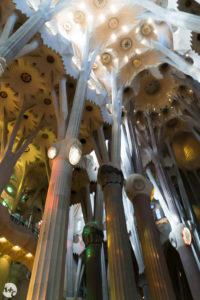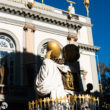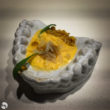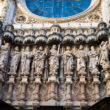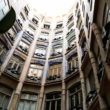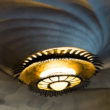Antoni Gaudi’s creations are unlike anything else in this world, and ninety years since his death architects and engineers are still scratching their heads at their genius and standing in awe of their exquisite beauty. Being an architect, I guarantee that if I were to try to design anything remotely similar in today’s world, I’d be told it can’t be done. Of course, that’s not true. Anything can be done with the right budget, creative team, and perhaps most importantly, the right patron – but the suggestion would be considered over-the-top and, well, just not practical. But as you walk through Gaudi’s built environments, you discover they are, in fact, practical. They have served, and continue to serve, as spaces to live, to work, to play, and to worship for decades. They are sculptural and fanciful with new discoveries around every corner, but they are also functional and purposeful. In short, they are some of the most wonderful examples of habitable art in the world.The creation continues incessantly through the media of man. But man does not create…he discovers.
-Antoni Gaudi
The last time Craig and I were in Barcelona, I revisited Casa Mila after my first visit more than twenty years prior, and toured Casa Batlló for the very first time. I still don’t know how I missed it the first time around as the two buildings are only a few blocks apart, but now I know so that’s what matters. We went back to both of these residential buildings on this trip, and I was once again struck by their beauty and to the precise attention to detail Gaudi infused all of his buildings with. Everything is carefully considered and designed in a rigorous fashion, and yet every detail still exudes a sense of spontaneity. The door knobs, the baseboards, the tiles: nothing is left to chance. And while the designs are fanciful, colorful, and even playful – words we don’t often use in contemporary architecture – they maintain a modernity that still feels relevant today.
Craig and I also re-traced our steps back to Sagrada Familia, which has been under construction for more than 130 years. It still has ten more to go in order to meet the completion goal in 2026, which will mark the 100th anniversary of Gaudi’s death – although most reports show there will still be some final “decorative” work that will continue into 2030 or beyond. Today, seventy percent of the work is complete. In the next ten years they will finish work on the six central towers, the tallest of which will be 172.5 meters high, making it Europe’s tallest religious building. The final major project will be to construct the Glory façade, which will house the main entrance at the south end of the basilica.
The first time I saw Sagrada Familia was in 1990, so it was more than twenty years of construction later when I was there last in 2013, and I couldn’t believe the progress that was made. In 1990 there was no roof and no real sense of enclosure; in 2013 it was a real building! I wasn’t sure what to expect over the last three years in terms of progress, but when I caught my first view of it from the roof of Casa Mila I could see the many cranes that don’t surround the church any longer but are literally sitting on top of it. I couldn’t figure out how or if the building was designed to support elevated cranes, but there they were. We had a great close-up view of them this time when we paid the additional fee to ride the elevator up in one of the towers on the Passion Façade. To our surprise, you do not actually go to the top of the tower – you only go about halfway up. Once you exit the elevator, you can walk to a small outdoor balcony to take in the view. When you are ready to leave, you walk down an extremely narrow spiral staircase to the ground floor that would never meet American building codes. Funny how they don’t tell you that you will have to walk down until you are in the elevator on your way up. I’m not sure it was really worth the extra money, but I’m glad we did it. Besides, construction is funded through ticket sales so I am happy to contribute to its completion.
From the interior, everything looked familiar but there was a new addition of the sacristy that had furniture, candelabras, and other church artifacts that Gaudi designed. The basilica itself was as spectacular as I remembered, especially with the sunlight beaming in from the brilliantly colored stained glass windows. Fiery reds and yellows on the passion side; cool greens and blues on the nativity side. If anything takes away from its extraordinary beauty, it’s the hordes of tourists, even though we were there in the off-season. Especially in today’s selfie-fueled environment, it’s becoming more and more difficult to find a moment of repose to absorb a space like this and contemplate the bigger questions of life, which is exactly what you are supposed to do in a sacred space. I’m not a religious person, but I do understand and appreciate the power of sacred spaces, and this one is like no other. But as with any significant monument, there will never be a way to experience the space the way it was intended. I’ve had a recurring conversation with several people over the years that – with all due respect – a job such as a janitor would give one the time to think that is so lacking in many of our lives. It’s a solitary job that doesn’t require collaboration, endless meetings, and constant derailments. I can only imagine that the night janitor at Sagrada Familia has the best opportunity to truly experience this remarkable building in private, in silence, and with the quiet time to ponder its greater meaning. With my on-going fantasy of moving to Barcelona, maybe I’ve identified my next career move.
 kimpluscraig.com
kimpluscraig.com

